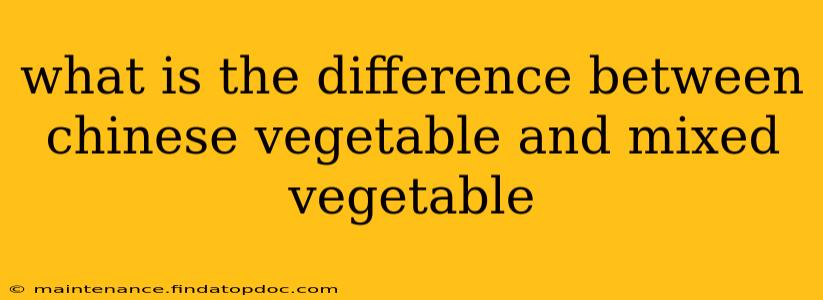What's the Difference Between Chinese Vegetable and Mixed Vegetable?
The terms "Chinese vegetable" and "mixed vegetable" are often used loosely, leading to confusion. The key difference lies in the specific ingredients and the intended culinary application. There isn't a strict, universally agreed-upon definition, but we can explore the typical components and uses to clarify the distinction.
What are Chinese Vegetables?
"Chinese vegetable" is a broad term encompassing a variety of vegetables commonly used in Chinese cuisine. It's not a specific mixture but rather a category. These vegetables often reflect the diverse culinary traditions across China's vast regions. Common ingredients might include:
- Bok Choy: A popular leafy green with a mild, slightly sweet flavor.
- Gai Lan (Chinese Broccoli): Slightly bitter and more robust than regular broccoli.
- Snow Peas: Sweet and tender young pea pods.
- Mushrooms (Shiitake, Oyster, Wood Ear): Various types of mushrooms add umami depth.
- Bean Sprouts: A crunchy and refreshing addition.
- Carrots: A common staple providing sweetness and color.
- Celery: Often used for its subtle flavor and texture.
- Bamboo Shoots: Add a unique, slightly sweet and crunchy texture.
- Water Chestnuts: Crisp and subtly sweet.
The specific composition of a "Chinese vegetable" mix will vary depending on the dish and the cook's preferences. It often features a combination of leafy greens, root vegetables, and perhaps mushrooms or other fungi. The overall profile tends to be relatively light and fresh, complementing the often savory and umami-rich flavors of Chinese cuisine.
What are Mixed Vegetables?
"Mixed vegetables" is an even broader term. It refers to a blend of various vegetables, with no particular cultural association. The composition can vary enormously depending on the product and its intended use. You'll find mixed vegetable blends in:
- Frozen vegetable mixes: These are typically convenient options for quick meals. They might include peas, carrots, corn, green beans, and other commonly frozen vegetables.
- Canned mixed vegetables: Similar to frozen mixes, but canned vegetables often have a softer texture due to the canning process.
- Restaurant-prepared mixed vegetables: Restaurants may use a variety of vegetables tailored to the specific dish.
- Fresh mixed vegetable salads: These could incorporate a wide range of vegetables, often with different textures and tastes.
The vegetables in a "mixed vegetable" mix can be quite diverse, sometimes including vegetables that wouldn't typically appear in a Chinese vegetable dish.
What is the Key Difference?
The core difference hinges on the intended use and cultural context. "Chinese vegetables" implies a selection tailored to the flavors and techniques of Chinese cooking. "Mixed vegetables" is a much more generic term, simply meaning a combination of various vegetables without a specific culinary focus.
Are there any overlaps?
Yes, absolutely. Some vegetables like carrots, mushrooms, and snow peas could appear in both types of mixtures. However, a "Chinese vegetable" mix would generally be more carefully curated to create a specific flavor profile complementing Chinese dishes, whereas "mixed vegetables" might be a more random assortment based on availability or cost.
How do I choose the right one for my recipe?
The best choice depends entirely on your dish. If you're making a stir-fry or another Chinese-inspired recipe, a "Chinese vegetable" mix (or carefully selected individual ingredients) will likely offer the most authentic and harmonious flavor profile. If you're making a soup, casserole, or other dish where a wide variety of vegetables is appropriate, then a "mixed vegetable" mix might be a more practical option.
